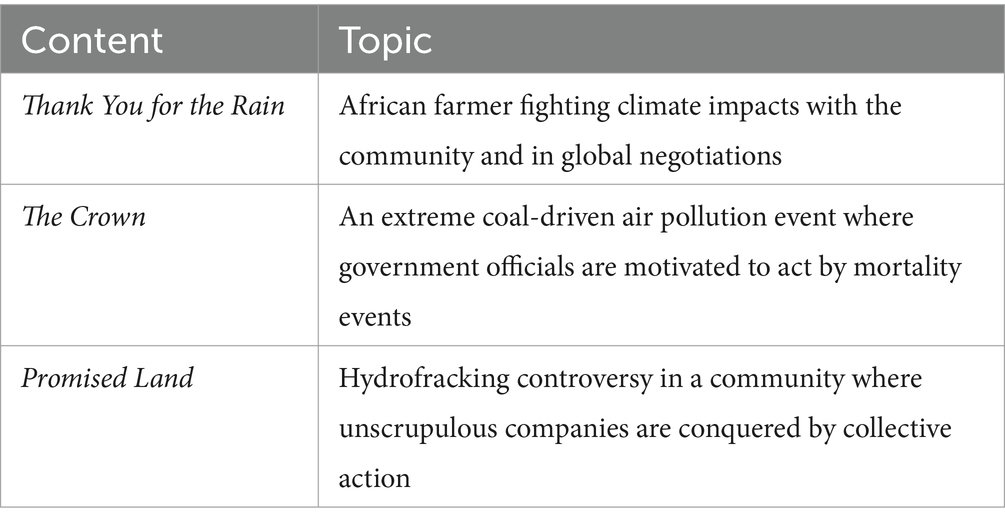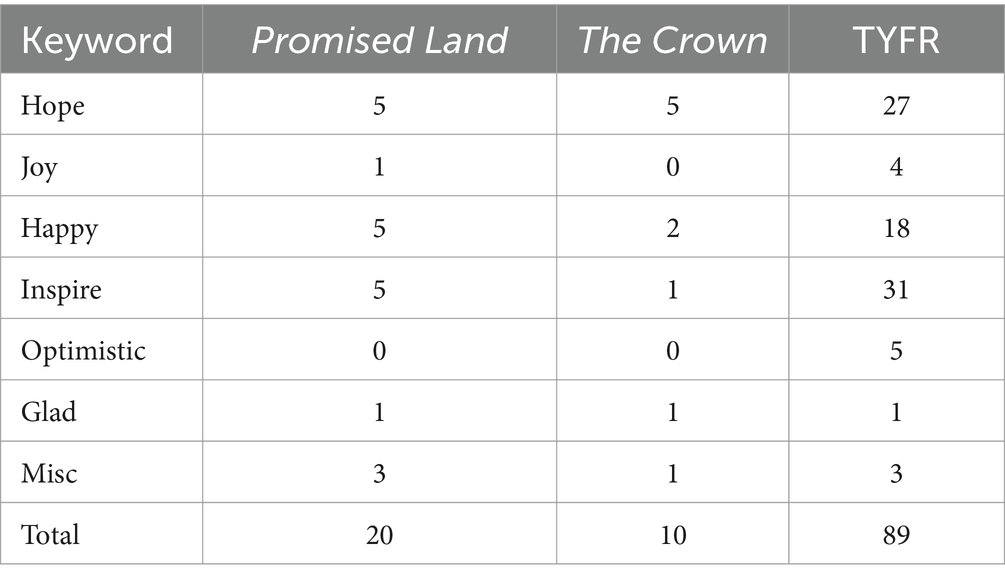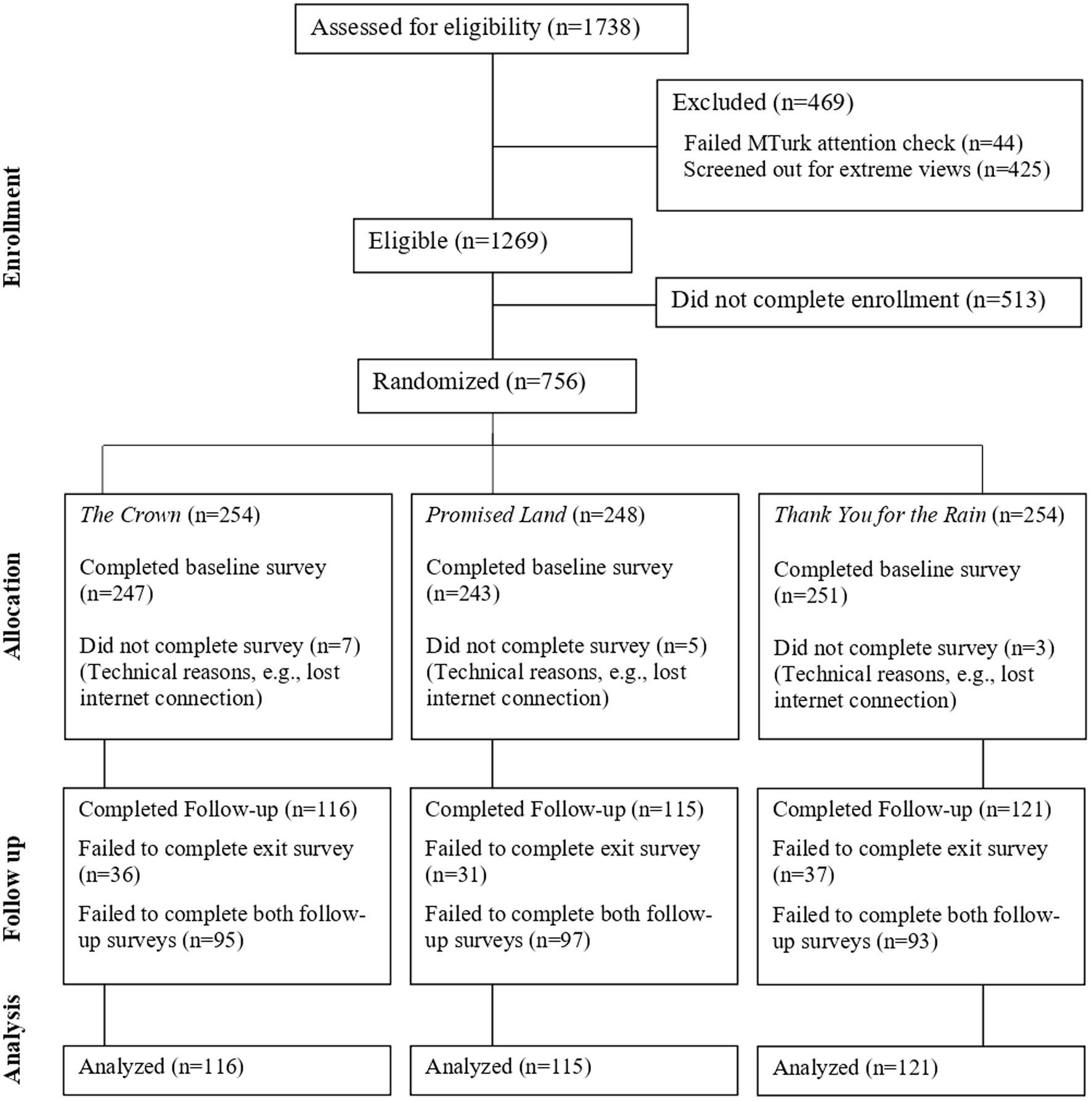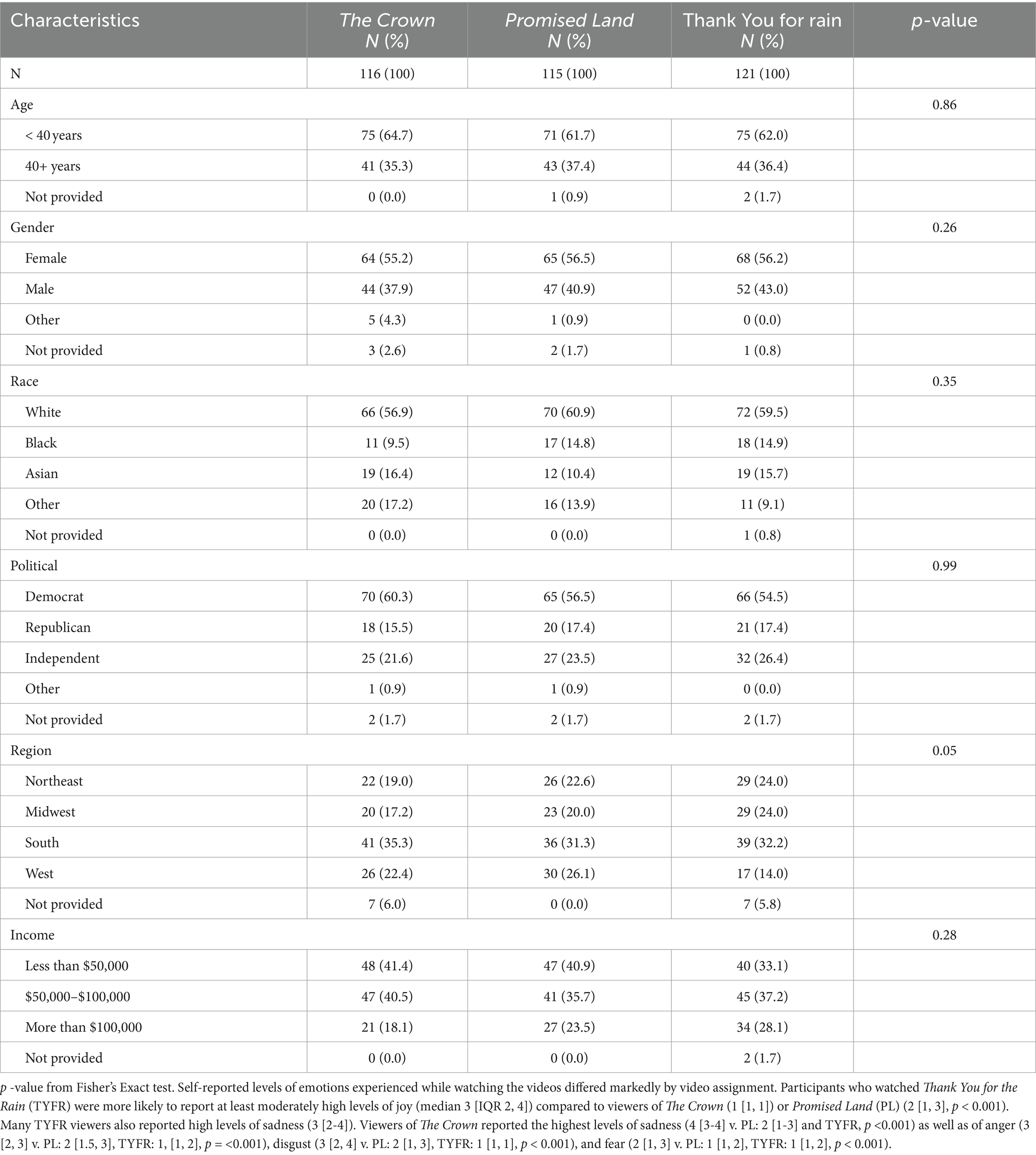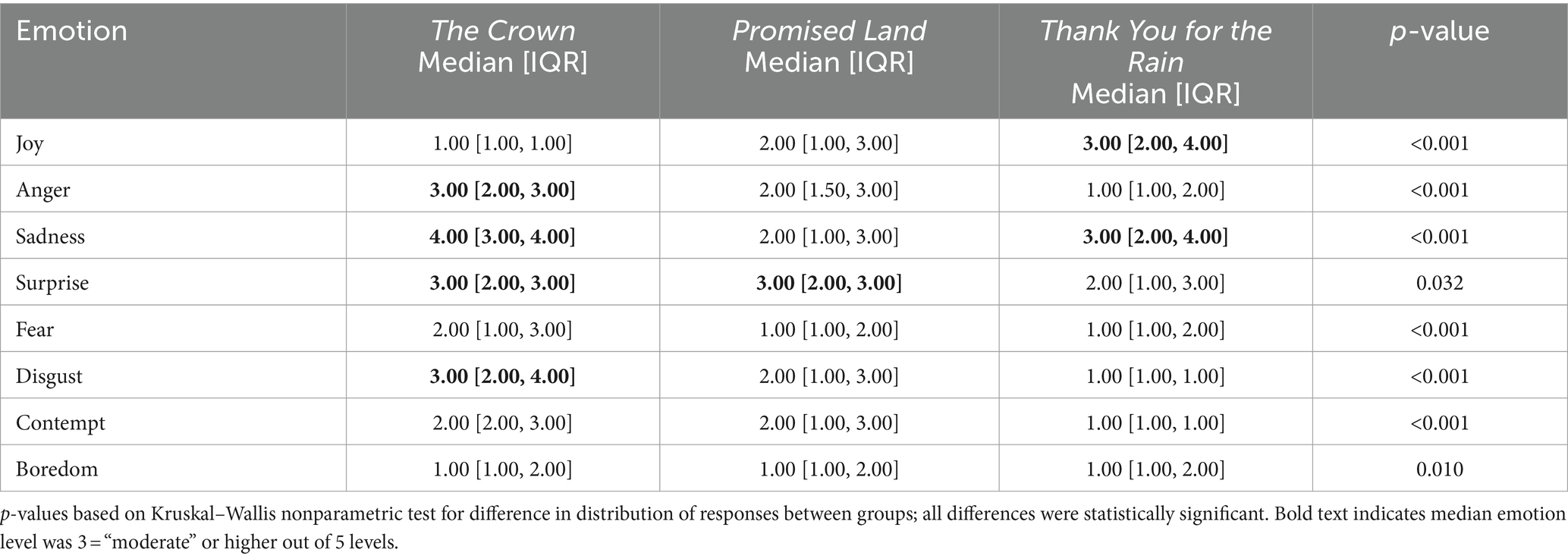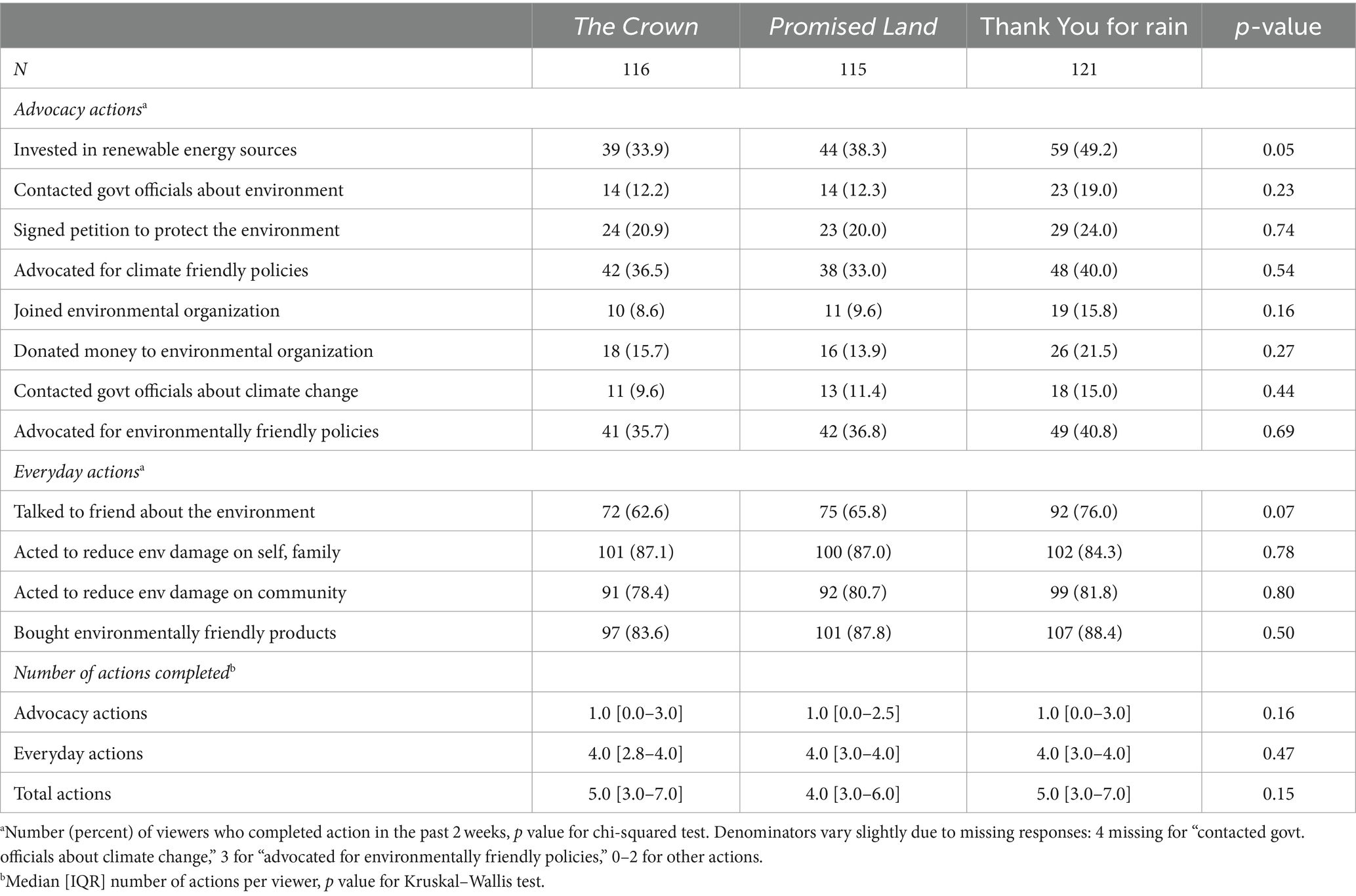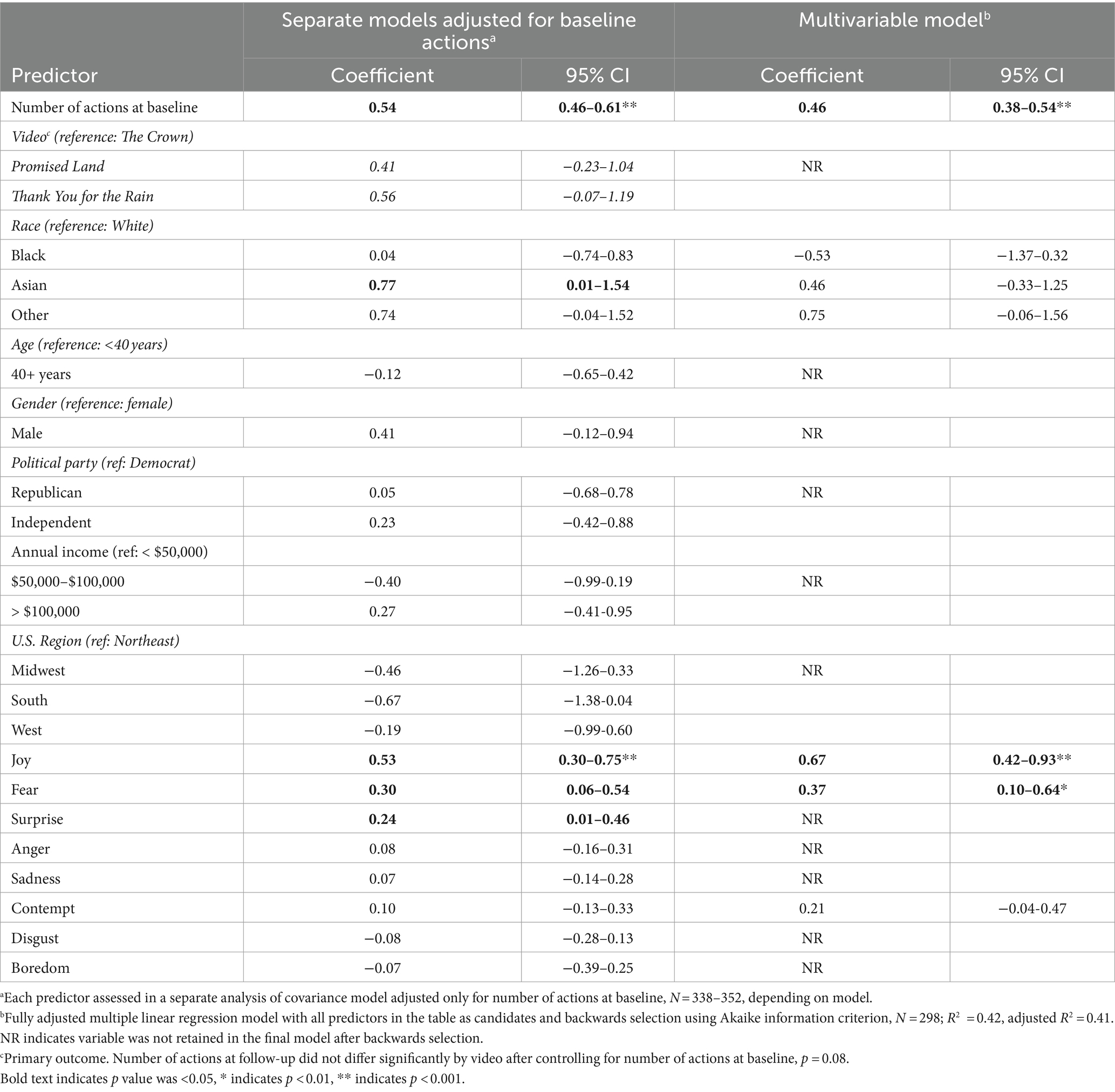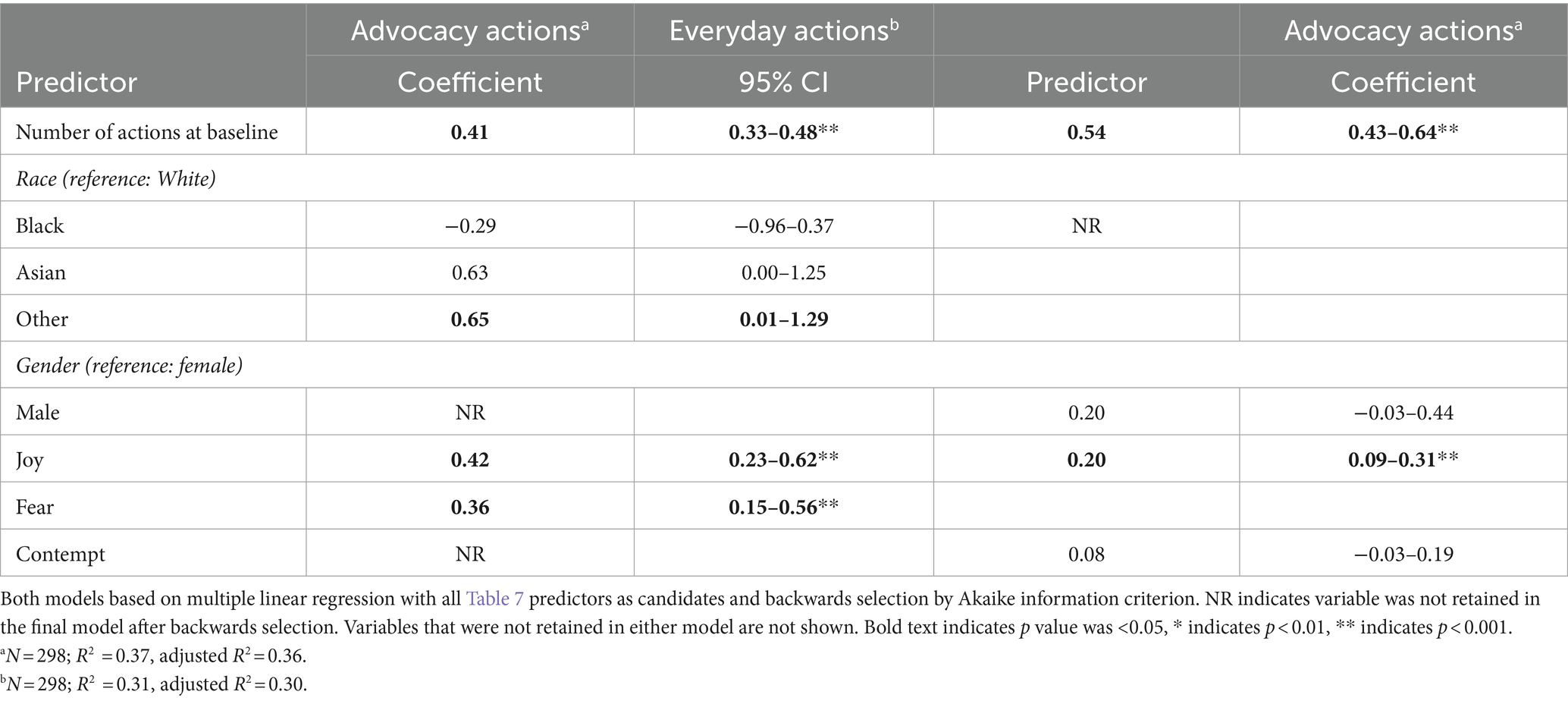- 1Milken Institute School of Public Health, The George Washington University, Washington, DC, United States
- 2Department of Epidemiology and Biostatistics, Milken Institute School of Public Health, George Washington University, Washington, DC, United States
- 3Independent Researcher, Los Angeles, CA, United States
Introduction: Reaching the public and engaging them in addressing climate change could be effectively motivated by film and television. Unfortunately, to-date, there is limited understanding regarding the mechanisms by which such media motivates behavior change to address climate. In this research, we sought to investigate how media exposure can motivate climate and environmentally-conscious behaviors by assessing how emotional responses of viewers or demographic characteristics affected subsequent behavior over weeks following exposure.
Methods: Participants (N = 352) were recruited online and randomly assigned to watch one of three video segments. In surveys before and 4 weeks after viewing, they reported on specific environmentally friendly actions they had taken in recent weeks. Using analysis of covariance (ANCOVA) adjusted for actions reported at baseline, we assessed whether the number of actions reported at follow-up differed by assigned video. Two ANCOVA models were pre-specified, one with video only and one with backwards selection on a list of demographic factors and emotions experienced while watching the videos.
Results: In the multivariable model, a higher level of action was associated with self-reported joy (p < 0.001) and fear (p < 0.01).
Discussion: These findings suggest that climate communication that engages audience members in a joyful emotional state or, to a lesser degree, a frightening experience may be most effective in increasing climate action.
Introduction
In recent years, climate change media coverage has been increasing with print and news media coverage hitting an all-time high in 2021, up 90% globally compared to 2015 (Boykoff et al., 2023). Recently, 33% of Americans report receiving news about global warming at least once a week (Howe et al., 2015). A larger number of documentary films and a few climate-related scripted films have also been released in recent years. Even as this exposure expands, climate anxiety has grown and Americans remain disengaged and feel disempowered when it comes to climate and related environmental action (Heald, 2017; Peeters et al., 2019; Leviston and Walker, 2020). In 2021, 72% Americans reported believing that global warming is happening, and 65% reported being concerned over the potential impacts (Marlon et al., 2024). Eighty percent of survey respondents, globally, claimed they are willing to change the way they live and work to reduce the effects of climate change, although studies determining how many actually engage in mitigation or adaptation behavior are limited (Bell et al., 2021).
Developing an understanding how media can play a role in catalyzing action on climate rather than depressing it or potentially even contributing to climate anxiety is needed. The effects of non-news film and television have been explored less despite their broad reach and potential to transcend news media echo chambers. These kinds of narrative visual portrayals are growing with edutainment and advocacy-based documentaries possibly growing the fastest of all climate film and video content. Our past research on how climate documentaries affect viewers demonstrated that certain emotions, such as anger, shock and optimism, invoked interest in action. Considering their mass reach and the potential of emotional invocation more than factually-based media, understanding how film and television affect behavior is critical.
In this research, we investigated how exposure to climate-related film or television can motivate climate and environmentally-conscious behaviors with a particular focus on the role of emotional experiences. Specifically, we aimed to assess whether changes in actions taken after watching video content differed by the emotional responses of viewers to content and whether these effects differed by demographic characteristics. We especially sought to move beyond a timeframe of before and immediately after media exposure to see effects over time. We also sought to identify what instigated emotions that led to action. In so doing, we attempt to further understanding of how climate communication correlates with behavior change.
In order to investigate this topic, we chose three pieces of content that contain emotionally diverse storylines and types of social action, including clips from The Crown, Thank You for the Rain, and Promised Land. The segment from The Crown addressed the severity of air-pollution and its negative effects on human health wherein action took place at the political level, by Prime Minister Winston Churchill. The clip depicted coal-driven air pollution and smog, and what it took for a government to act that was largely isolated from the most severe consequences. Thank You for the Rain showed the impact of climate change on a rural farming community in Kenya, and how a farmer with limited resources was able to reduce these impacts in his community with his family. Promised Land dramatized the controversial effects of hydrofracking on a community (which releases methane) and demonstrated how the community can stand together to prioritize health and environment. We examined environmental and climate-related behaviors before watching and up to four weeks after. We seek to contribute to the resolution of controversies regarding which emotional states, such as fear or optimism, are elemental to fostering climate action, and story elements that affect these outcomes.
Emotions play a pivotal role in an individual’s decision-making process and evoking action tendencies (Salama and Aboukoura, 2017), including engagement with or avoidance of an issue (Maxwell and Davidson, 2007). This is also true of climate change (Harth, 2021), although the research to-date has resulted in controversies regarding which emotions instigate specific outcomes. Some research has suggested that negative emotions and affect, such as worry, fear, anger, and guilt, increase awareness and concern about the climate crisis and may predict climate mitigation or adaptive behaviors (Harth et al., 2013; Wang et al., 2018; van Vlkengoed and Steg, 2019; Goldberg et al., 2020; Harth, 2021). Some studies have shown that these feelings can be leveraged to promote pro-environmental actions and result in better engagement in climate activism (Ogunbode et al., 2022). People may also be less likely to engage in unethical behaviors if they believe that it will result in negative emotions or moral judgment (Onwezen et al., 2013; Winterich et al., 2014) and with that expectation may be more likely to act in socially acceptable and pro-environmental ways (Barberá-Tomás et al., 2019). Similarly, some research has shown that negative framing and the threat of loss increases the willingness to make sacrifices, while gain frames decrease such willingness (Bilandzic et al., 2017). This suggests that the greatest motivation for climate action might be based on scary or fearful framing or media.
Yet, other findings have countered this idea. Research has shown that the invocation of negative emotions can instill hopelessness, causing emotions such as eco-anxiety and paralysis that prevent action (Wong-Parodi and Feygina, 2021). Eco-anxiety may result in high levels of stress that wear away an individual’s ability to act, resulting in lower engagement in individual and collective pro-climate behaviors (Stanley et al., 2021; Kurth and Pihkala, 2022). Additionally, eliciting emotions such as hope, interest, compassion, and worry have been found to increase public engagement and act as predictors of climate-friendly policy support (O’Neill and Nicholson-Cole, 2009; Höijer, 2010; Harth et al., 2013; Lu and Schuldt, 2016; Feldman and Hart, 2017; Nabi et al., 2018; Goldberg et al., 2020; Brosch, 2021). Some kinds of positive emotions have resulted in “impactful actions”, such as high impact behaviors like reducing meat consumption or on low impact like changing a light bulb to LED (Schneider and van der Linden, 2023). These findings suggesting that positive emotions are more motivational in inducing climate action.
Reactions to media exposure may depend on the identity of an individual. Narratives that create a strong negative feeling have been shown to be more effective at changing climate attitudes in conservatives (Goldberg et al., 2020). In one study, Democrats and women responded more strongly to emotional appeals than their male and republican counterparts, who preferred more neutral framing (Bloodhart et al., 2019). Those who believed in manmade climate change responded more hopefully to messages of public health, security and other messages, while a national security angle elicited extreme anger from those who were climate change deniers (Myers et al., 2012). As such, it is possible that demographic characteristics, pre-existing beliefs, or political affiliation could have distinct effects on behaviors subsequent to media exposure.
These differences may reflect that while emotions are important, they are only one aspect of a cognitive system that shapes the transformation from emotion to action (Chapman et al., 2017). The type of storytelling or presentation of information intersects with this. Boomerang effects or pushback to climate information has taken place with some populations with certain approaches. More specifically, narrative storytelling as compared to factual information has shown to facilitate engagement and enhance pro-climate behaviors (Morris et al., 2019). The few studies dedicated to big budget climate films like The Day After Tomorrow have shown mixed results, demonstrating that audiences are affected and motivated by such films (Mossner, 2012; Sakellari, 2014), but that they may not always shown to be the most effective for changing beliefs (Cooper and Nisbet, 2017). Beattie et al. (2011) found that An Inconvenient Truth fostered negative emotional experiences while also increasing viewers’ motivation and sense of self-efficacy (Beattie et al., 2011). Howell found similar responses from viewers of The Age of Stupid along with reported subsequent mitigation behaviors (Howell, 2011).
Specific kinds of storylines can also engender particular kinds of emotional reactions and actions. Those about health have elicited greater concern than some others, such as national security (Myers et al., 2012). In the context of a large problem like climate change, collective action and self-efficacy affects audience reactions. Our past research has shown that audiences are acutely sensitive to whether or not their individual actions could be a part of collective action and shapes their emotional response to content. More research is needed on how emotional experiences lead to action (Brosch, 2021).
Actions may also be mediated by time. The immediacy with which actions are taken following media exposure also shapes outcomes (Brosch, 2021). Very little research has tracked media effects beyond immediate post-viewing. The little research that has tracked change over time demonstrates that early effects do not persist (Howell, 2011). Our research contributes to the understanding of how media instigates different emotional reactions in the context of climate storytelling and how that instigates self-reported action during the month following media exposure.
Materials and methods
We conducted a mixed methods study involving a randomized 1:1:1 three-arm parallel group experiment involving United States participants recruited online and the evaluation of open-ended questions that resulted in qualitative textual data. All study activities and data collection were conducted online.
Participants
Between April 2021 and February 2022, 1,738 potential participants were screened using Amazon’s Mechanical Turk (MTurk) online crowdsourcing platform. In order to recruit from MTurk, researchers establish an account on Amazon and post a job listing describing the “Human Intelligence Task” being asked of workers, together with the compensation being offered. When MTurk workers log onto their accounts, they may choose to undertake tasks for which they are eligible; in our case, we required that they be U.S. residents and 18 years of age or older. In addition, because we wished to evaluate the impact of the intervention on Americans with at least minimal concern about climate change, we imposed a 7-question screening survey assessing attitudes about climate change and excluded 425 applicants who indicated that humans do not cause climate change and that the climate is not changing (Supplementary material 1, Supplementary material questions 3, 4). In order to assure we were recruiting participants and not bots, we included a question in the screener. This resulted in 1,269 eligible workers. In this way, we consented and enrolled a total of 756 participants.
Limited resources necessitated that we add new participants a few at a time; thus, the enrollment survey was provided to participants as we were able to accommodate them, with the delay resulting in some drop-out. We also employed an attention check process that involved human review of all recorded videos of participants’ faces to ensure their faces were legible to facial recognition software being used for another aspect of this study. This software mandates that the whole face is visible and viewers are engaged with the screen. Other factors related to dropout before enrollment include internet connectivity issues and website maintenance. To make sure we had a racially diverse study population, we oversampled people of color on a weekly basis. New participants were randomly assigned to a study arm in 1:1:1 ratio, stratified by race (White vs. other race). We used Excel’s RAND function to randomly sort new participants and the GraphPad QuickCalcs website,1 (accessed May 2021 to February 2022), to generate a list of random assignments, which we pasted into Excel next to the sorted participant list. The study was approved by The George Washington University Institutional Review Board Study number NCR202326. Participants provided electronic consent and received a total of 22–30 dollars for completion of all four surveys.
Intervention and study activities
Three video segments used in the study were from The Crown, Thank You for the Rain, and Promised Land. These pieces of content varied across identify of protagonist and emotional experience invoked for audiences, as well as scale of social action – personal, community or political. They were also the highest quality film segments that we could gain access to for research purposes that were diversified in these ways. We also varied the selection of content across climate topic. These videos were selected to vary across demographics of the main character (Table 1).
Participants completed four surveys, one before viewing, one immediately afterward, and follow-up surveys two and four weeks later (see Supplementary material 1 Survey). The initial survey consisted of 80 items exploring beliefs, attitudes, and actions taken to address climate change and environmental issues. Later surveys repeated subsets of these questions, adapted for context. In the survey taken immediately after watching, and during the two and four week follow-up, participants answered qualitative questions about their reactions to the video and rated the intensity of eight different emotions potentially experienced while viewing. Each survey included a panel of 12 specific actions participants might take to address environmental issues, for example, “talk to a friend about threats to the environment,” or “contact government officials to urge them to take action to reduce climate change.” Before viewing, participants answered how frequently they had taken each action during the previous six months, and at each follow-up survey, they reported how frequently they had taken the actions during the prior two weeks.
The primary quantitative outcome was the number of actions taken during the prior two weeks, as reported four weeks after watching the video, adjusted for the number of actions reported at baseline. We were interested in whether the effect of viewing would differ according to the video content and participants’ emotional responses.
We also collected qualitative data in the form of open-ended questions for all survey participants. The qualitative responses looked at the free responses for The Promised Land, The Crown, and Thank you for the Rain. Once the quantitative data were analyzed, we used inductive coding to select qualitative data that could help explain the key quantitative findings regarding the role of positive emotions and their instigation.
Quantitative analysis
After watching the video segment, participants used a 5-point Likert scale to rate the level of each emotion they felt, from “not at all” (1) to “extremely” (5). Emotion levels were compared between the three randomization groups using the Kruskal–Wallis nonparametric test for differences in distribution between groups, and demographic characteristics were compared with Fisher’s Exact test. We dichotomized the responses for actions taken during the recent past, which were reported on a frequency scale ranging from never (1) to always (5). We recoded these as no, not taken (response 1) or yes, taken at least once during the period (responses 2–5). Then we calculated the proportion of participants who completed each action and the median number of actions taken, stratified by randomization group, and compared the three groups using chi-squared and Kruskal–Wallis tests, respectively.
To assess the primary research question, whether change in action level after watching would differ by video content, we performed a prespecified analysis of covariance (ANCOVA) comparing the number of actions at four weeks follow-up between the three study arms (video groups) while controlling for the baseline number of actions.
For the exploratory multivariable analysis, we fit a multiple linear regression model with the number of actions taken at four weeks as the outcome and a prespecified list of demographic variables and emotions as candidate predictors. These were chosen based on their potential association with the outcome and included video watched, age, gender, race, political party, geographic region, income, and the eight emotions measured in the survey. To arrive at the final model, we used backwards selection based on the Akaike information criterion (AIC). This method identifies and drops independent variables that do not add explanatory power, improving the accuracy of effect measurement for the variables that remain in the model (Heinze et al., 2018). We determined statistical significance in the final model using alpha = 0.05.
We also evaluated each candidate predictor in a separate ANCOVA model containing only the predictor plus the baseline number of actions taken. We chose this approach rather than standard bivariate analysis because our question was the degree to which the level of engagement changed after watching the video, not simply whether certain characteristics were associated with higher engagement in general.
Finally, to explore whether participant behaviors might group together according to some underlying construct(s), we used R’s psych package (version 2.1.9) to perform factor analysis on responses for actions taken at baseline. Parallel analysis and Velicer’s Minimum Average Partial Test were used to determine the appropriate number of factors, after which we applied minimum residual factor analysis with oblimin rotation. Based on the resulting pattern loadings, we grouped items into categories according to the factor with which they were most highly correlated. We repeated the factor analysis on actions completed at four weeks post-video and found the same groupings. The analysis was done using R version 4.1.0. (R Core Team, 2022).
Sample size calculation: We determined that for testing group differences in mean number of actions taken at the 4-week follow-up, a group size of 82 would provide 80% power to detect a standardized effect size (Cohen’s F) of 0.2, assuming a 3-group analysis of variance, alpha = 0.05. The planned ANCOVA test was expected to have similar or greater power, depending on the degree of correlation between pre and post scores. For testing independent associations of predictors (e.g., video assignment, race, emotional responses) with the outcome in a multivariable model with 10 predictors, a total sample size of 343 would provide 80% power to detect a partial correlation of 0.15. Sample size calculations were done in SAS 9.4 (SAS Institute, Cary, NC).
Qualitative analysis
To understand what aspects of each clip elicited feelings of joy, we looked at the open responses for the question “In your own words, how did this story make you feel?” From these responses, we used five keywords to identify the theme of joy, including “Happy,” “Joy,” “Hopeful,” “Glad,” “Optimistic,” and “Inspired” (See Table 2). We then used an inductive approach to identify responses regarding story themes and occurrences that elicited these positive feelings. Each piece of content was coded separately in order to facilitate identification of elements that might be specifically reflected in the codes (See Table 3). Responses that included these keywords were then categorized based on the theme that evoked those feelings.
For The Crown, one category appeared in which respondents referred to government action, including action through Queen Elizabeth or Churchill. The Promised Land clip also had one category emerge, which referenced the community standing up for themselves. Lastly, Thank you for the Rain had two categories that appeared, individual and community action. Individual action referenced leadership and ability to motivate others, while community action referenced community members coming together to make change. All three clips had an added category in which respondents did not provide an explanation of what prompted joy.
Results
Of the 756 participants enrolled, 352 (47%) completed all four surveys (Figure 1). Compared to participants who dropped out, those included in the final analysis were similar in terms of demographic characteristics (p > 0.05 for all) but differed by frequency of actions taken during the six months prior to baseline. The mean number of actions taken by those who completed the study was 6.38 out of 12, compared to 7.16 for those who dropped out (p = 0.002).
Characteristics in the analysis sample were similar across randomization groups, although Thank You for the Rain had slightly higher proportions of viewers from the Northeast and Midwest, compared to the other groups, while The Crown had more from the South and Promised Land from the West (p = 0.05). Overall, 63% of participants were under 40 years of age, and 56% were female. By race, 59% were White, 13% Black, 14% Asian and 13% of other or mixed race. Democrats were overrepresented at 57%, compared to 17% Republican and 24% Independent (Table 4).
Cronbach’s alpha for the 12-item action scale was 0.90 (95% CI 0.89–0.92) for the initial survey and 0.91 (0.90–0.92) at the four-week follow-up. For the subscale of everyday actions, alpha was 0.82 (0.79–0.85) at baseline and 0.84 (0.81–0.87) at four weeks. Alpha for advocacy actions was 0.90 (0.88–0.92) at baseline and 0.92 (0.90–0.93) at follow-up. In factor analysis, eight actions loaded onto the first factor, which we labeled “advocacy actions,” and four onto the second, “everyday actions.” Factors 1 and 2 explained 38 and 33% of the variance, respectively, and the correlation between factors was 0.39. Based on these results, we repeated the regression analysis for each group of actions, i.e., using number of advocacy actions and then number of everyday actions at follow-up as outcomes.
Self-reported levels of emotions experienced while watching the videos differed markedly by video assignment (Table 5). Participants who watched Thank You for the Rain (TYFR) were more likely to report at least moderately high levels of joy (median 3 [IQR 2, 4]) compared to viewers of The Crown (1 [1, 1]) or Promised Land (PL) (2 [1, 3]), p < 0.001. Many TYFR viewers also reported high levels of sadness (3 [2–4]). Viewers of The Crown reported the highest levels of sadness (4 [3–4]) v. PL: 2 [1–3] and TYFR, p < 0.001) as well as of anger (3 [2, 3] v. PL: 2 [1.5, 3], TYFR: 1, [1, 2], p = <0.001), disgust (3 [2, 4] v. PL: 2 [1, 3], TYFR: 1 [1, 1], p < 0.001), and fear (2 [1, 3] v. PL: 1 [1, 2], TYFR: 1 [1, 2], p < 0.001).
At the four-week follow-up, higher proportions of viewers reported completing everyday actions, compared to advocacy actions, during the prior two weeks (Table 6). Each everyday action had been completed at least once by 68–87% of participants, overall. Among advocacy actions, investing in renewable energy sources (41%) or advocating for environmentally conscious (38%) or climate conscious (37%) policies had the highest completion rates, while contacting government officials about climate change (12%) and joining an organization (11%) had the lowest. For all but one specific action, higher proportions of Thank You for the Rain viewers reported having completed them. The largest differences were for investing in renewables and talking to a friend about the environment, but none were statistically significant. The median number of actions taken was five (four everyday and one advocacy) for The Crown and Thank You for the Rain, and four for Promised Land.
In the primary analysis of covariance, when adjusted for the baseline number of actions, the average number of actions at follow-up was higher by about half an action for viewers of Thank You for the Rain (coefficient (b) = 0.56, p = 0.08) and Promised Land (b = 0.41, p = 0.21), compared to viewers of The Crown (reference group), but the differences were not statistically significant (Table 7). (The letter “b” above refers to the regression coefficient and indicates the average difference in number of actions taken for participants in one group, compared to the reference group). Not shown in a table, the same pattern was true for advocacy actions (Thank You for the Rain: b = 0.33, p = 0.19, Promised Land: b = 0.22, p = 0.40) and everyday actions (Thank You for the Rain: b = 0.26, p = 0.06, Promised Land: b = 0.17, p = 0.23), though again not statistically significant.
In separate ANCOVA models, we measured the association of each potential predictor with the total number of actions taken at follow-up, adjusted only for the number of actions taken at baseline. In these preliminary models, the number of actions taken at follow-up increased along with self-reported levels of joy (b = 0.53, p < 0.001), fear (b = 0.30, p = 0.02), and surprise (b = 0.24, p = 0.04) experienced while viewing the video. Asian (b = 0.77, p = 0.05) and participants of “other” race (b = 0.74, p = 0.06) completed more actions than White participants, with differences of borderline statistical significance (Table 7, columns 2–3).
In the fully adjusted multivariable model (Table 7, columns 4–5), all of the potential predictors shown were entered as candidates. After backwards selection, five of these were retained in the final model. The number of baseline actions remained a highly significant predictor, as did reported level of joy. Emotions were measured on a five-point Likert scale. For each one-point increase in reported level of joy, the mean increase in number of actions completed during the previous two weeks was 0.67 (p < 0.001). Actions also increased along with fear (b = 0.37, p < 0.01). Race and contempt were retained in the model but were not statistically significant.
We repeated the linear regression analysis for each of the action types (advocacy and everyday) and show the results of the fully adjusted models in Table 8. As expected, the number of actions at baseline was a significant predictor in both models (p < 0.001). The model for advocacy actions was similar to the overall model, with the number of actions positively associated with joy and fear. Greater joy was also associated with an increased number of everyday actions, though less strongly, and there were no other statistically significant associations in this model.
We found that most participants reported taking action to address environmental issues and climate change prior to exposure. As would be expected, people had integrated everyday actions and things that they had the power to do by themselves more fully into their lives than advocacy actions. Still, at least half reported engaging in at least one advocacy action in the past two weeks.
When adjusted for baseline action level, viewers of Thank You for the Rain and Promised Land completed more actions at follow-up than viewers of The Crown. These differences were not statistically significant but approached statistical significance for Thank you for the Rain (95% confidence interval –0.07 to 1.19, for clarity). This difference may be explained by the emotional response of many viewers to that story. In multivariable analysis, the factors most significantly associated with increased action were viewer-reported experience of joy and, to a lesser extent, fear. The fact that these remained statistically significant after adjustment for other factors, including the number of actions reported at baseline and race, and other emotions, provides evidence that they may be important independent motivators of subsequent action. The effects of both joy and fear were greater on advocacy actions than everyday actions, possibly because the level of everyday action was universally high.
Our study has some limitations. While the analyses were prespecified, the research was exploratory in the sense that we did not have formal hypotheses about which emotions would be associated with change in action level after the intervention. The video segments were diverse in content, format, and characters depicted and so we cannot rule out the possibility that factors not included in the analysis influenced the outcomes. Amazon’s MTurk worker pool has been studied extensively and found to be more diverse and comparably reliable and honest, compared to other convenience samples (citations 32–36). MTurk workers residing in the U.S. tend to be young, well educated, and liberal. Our sample was diverse in terms of age, gender, race, geographic region, and income but was young and more likely to endorse Democratic party affiliation compared to U.S. adults in general. Furthermore, we screened out candidates who categorically disavowed climate change. For these reasons, our findings represent our target population reasonably well but may not be generalizable to the entire public.
While self-report is not a perfect measure, it provides some insight regarding the emotional experiences and other story elements that will most strongly encourage climate-conscious behaviors. It is possible that there are explanations for a joyful reaction other than the character or plot, such as a predisposition to joy or simply feeling pleased with engaging in entertainment. However, these explanations seem unlikely considering each piece of content had very divergent levels of joy that, when examined across the timeline of the content itself, appear to reflect the import of the content itself. Furthermore, the design of the study, including randomization and identical procedures between study arms, makes it likely that any reporting bias would be evenly distributed across study arms.
To provide further insights into the relationships between joy, fear, and engagement, we reviewed the responses to open-ended questions. Participants who endorsed high levels of joy frequently said they felt inspired or encouraged about the potential of activism and engagement with one’s community to protect the environment. The responses by participants reporting fear express a sense of vulnerability that motivates them to want to protect themselves.
Joy was most often reported by viewers of Thank You for the Rain. Viewers expressed feeling encouraged and inspired, and responded positively to the main character, Kisilu, whom they described as being optimistic and passionate about helping his community. Feelings of happiness and joy were most often mentioned in the context of types of action being taken. Thank You for the Rain and Promised Land both elicited joy in the context of community action, while The Crown was government action and Thank You for the Rain also included individual action. Themes of empathy to see a community or government official responding to the difficulty faced by one character were common, whereas in Promised Land, most joyful experiences were in regards to community responses to corporate dominance.
Discussion
This research represents the first comprehensive analysis of climate change actions instigated over time in reaction to media exposure. A strength of our study was the random assignment of viewers to study arms, which resulted in good distribution of most variables, including political party affiliation, and fair distribution of U.S. region. Somewhat surprisingly, neither party nor region was significantly associated with reported action level at follow-up when adjusted for baseline actions; and although both were entered into the multivariable model as candidates, neither was retained as adding explanatory power to the model.
Our findings offer novel insight into emotional experience as an important aspect of climate motivation and indicate that joy, especially, and fear to a lesser degree, may be key motivators. This supports past research that claims empowering messaging will be more effective at behavior change in the climate arena than fear-inducing, and provides no support for research indicating that anger is a strong motivator. We further specify the types of story elements that might lead viewers to feel empowered in a way that motivates action. The qualitative responses of our participants suggest that effective group action and individual optimism and joy on screen engages viewers, reinforcing our past research that demonstrated viewers’ interest in understanding social involvement in climate action. We also further specify the kinds of actions that joyful content, in particular, can motivate, adding to the literature exploring high and low impact actions. Specifically, we see that media experiences can motivate advocacy actions, which were less frequently engaged in at baseline compared to everyday actions.
Overall, our findings suggest that climate change communication, including film and television, may be most motivational when incorporating joyful emotional elements that demonstrate the power of the collective. This research offers insight for creators and others who are interested in using stories to motivate social change in the film and television arena, specifically.
Data availability statement
The raw data supporting the conclusions of this article will be made available by the authors, without undue reservation.
Ethics statement
The studies involving humans were approved by George Washington University Institutional Review Board. The studies were conducted in accordance with the local legislation and institutional requirements. The participants provided their written informed consent to participate in this study.
Author contributions
SM: Conceptualization, Funding acquisition, Investigation, Methodology, Project administration, Supervision, Writing – original draft, Writing – review & editing. AA: Conceptualization, Formal analysis, Methodology, Supervision, Writing – original draft, Writing – review & editing. LY: Data curation, Investigation, Writing – original draft.
Funding
The author(s) declare that financial support was received for the research, authorship, and/or publication of this article. This work was supported by the Robert Wood Johnson Foundation grant #77125 to SM, AA, and LY.
Conflict of interest
The authors declare that the research was conducted in the absence of any commercial or financial relationships that could be construed as a potential conflict of interest.
Publisher’s note
All claims expressed in this article are solely those of the authors and do not necessarily represent those of their affiliated organizations, or those of the publisher, the editors and the reviewers. Any product that may be evaluated in this article, or claim that may be made by its manufacturer, is not guaranteed or endorsed by the publisher.
Supplementary material
The Supplementary material for this article can be found online at: https://www.frontiersin.org/articles/10.3389/fcomm.2024.1410775/full#supplementary-material
Footnotes
References
Barberá-Tomás, D., Castelló, I., de Bakker, F. G., and Zietsma, C. (2019). Energizing through visuals: how social entrepreneurs use emotion-symbolic work for social change. Acad. Manag. J. 62, 1789–1817. doi: 10.5465/amj.2017.1488
Beattie, G., Sale, L., and Mcguire, L. (2011). An inconvenient truth? Can a film really affect psychological mood and our explicit attitudes towards climate change? Semiotica 2011, 105–125. doi: 10.1515/semi.2011.066
Bell, J., Poushter, J., Fagan, M., and Huang, C. In response to climate change, citizens in advanced economies are willing to alter how they live and work. Pew Research Center’s Global Attitudes Project (2021). Available at: https://www.pewresearch.org/global/2021/09/14/in-response-to-climate-change-citizens-in-advanced-economies-are-willing-to-alter-how-they-live-and-work/. (Accessed: 24th March 2024)
Bilandzic, H., Kalch, A., and Soentgen, J. (2017). Effects of goal framing and emotions on perceived threat and willingness to sacrifice for climate change. Sci. Commun. 39, 466–491. doi: 10.1177/1075547017718553
Bloodhart, B., Swim, J. K., and Dicicco, E. (2019). “Be worried, be very worried:” preferences for and impacts of negative emotional climate change communication. Front. Commun. 3:63. doi: 10.3389/fcomm.2018.00063
Boykoff, M., Katzung, J., Nacu-Schmidt, A., Olivia, P., and Fernández-Reyes, R. A review of media coverage of climate change and global warming in 2022. MeCCO Monthly Summaries: Media and Climate Change Observatory (2023). Available at: https://scholar.colorado.edu/concern/articles/3b591994v (Accessed: 24th March 2024)
Brosch, T. (2021). Affect and emotions as drivers of climate change perception and action: a review. Curr. Opin. Behav. Sci. 42, 15–21. doi: 10.1016/j.cobeha.2021.02.001
Chapman, D. A., Lickel, B., and Markowitz, E. M. (2017). Reassessing emotion in climate change communication. Nat. Clim. Chang. 7, 850–852. doi: 10.1038/s41558-017-0021-9
Cooper, K. E., and Nisbet, E. C. (2017). Documentary and edutainment portrayals of climate change and their societal impacts. Oxf. Res. Encycl. Clim. Sci. doi: 10.1093/acrefore/9780190228620.013.373
Feldman, L., and Hart, P. S. (2017). Is there any hope? How climate change news imagery and text influence audience emotions and support for climate mitigation policies. Risk Anal. 38, 585–602. doi: 10.1111/risa.12868
Goldberg, M. H., Gustafson, A., Ballew, M. T., Rosenthal, S. A., and Leiserowitz, A. (2020). Identifying the most important predictors of support for climate policy in the United States. Behav. Public Policy 5, 480–502. doi: 10.1017/bpp.2020.39
Harth, N. S. (2021). Affect, (group-based) emotions, and climate change action. Curr. Opin. Psychol. 42, 140–144. doi: 10.1016/j.copsyc.2021.07.018
Harth, N. S., Leach, C. W., and Kessler, T. (2013). Guilt, anger, and pride about in-group environmental behaviour: different emotions predict distinct intentions. J. Environ. Psychol. 34, 18–26. doi: 10.1016/j.jenvp.2012.12.005
Heald, S. (2017). Climate silence, moral disengagement, and self-efficacy: how Albert Bandura’s theories inform our climate-change predicament. Environ. Sci. Policy Sustain. Dev. 59, 4–15. doi: 10.1080/00139157.2017.1374792
Heinze, G., Wallisch, C., and Dunkler, D. (2018). Variable selection - A review and recommendations for the practicing statistician. Biom. J. 60, 431–449.
Höijer, B. (2010). Emotional anchoring and objectification in the media reporting on climate change. Public Underst. Sci. 19, 717–731. doi: 10.1177/0963662509348863
Howe, P. D., Mildenberger, M., Marlon, J. R., and Leiserowitz, A. (2015). Geographic variation in opinions on climate change at state and local scales in the USA. Nat. Clim. Chang. 5, 596–503. doi: 10.1038/nclimate2583
Howell, R. A. (2011). Lights, camera … action? Altered attitudes and behaviour in response to the climate change film the age of stupid. Glob. Environ. Chang. 21, 177–187. doi: 10.1016/j.gloenvcha.2010.09.004
Kurth, C., and Pihkala, P. (2022). Eco-anxiety: what it is and why it matters. Front. Psychol. 13:814. doi: 10.3389/fpsyg.2022.981814
Leviston, Z., and Walker, I. (2020). The influence of moral disengagement on responses to climate change. Asian J. Soc. Psychol. 24, 144–155. doi: 10.1111/ajsp.12423
Lu, H., and Schuldt, J. P. (2016). Compassion for climate change victims and support for mitigation policy. J. Environ. Psychol. 45, 192–200. doi: 10.1016/j.jenvp.2016.01.007
Marlon, J., Emily, G., Peter, H., Matto, M., Martial, J., Eric, F., et al. (2024). Available at: https://climatecommunication.yale.edu/visualizations-data/ycom-us/ (Accessed: 24th March 2024).
Maxwell, J. S., and Davidson, R. J. (2007). Emotion as motion. Psychol. Sci. 18, 1113–1119. doi: 10.1111/j.1467-9280.2007.02033.x
Morris, B. S., Chrysochou, P., Christensen, J. D., Orquin, J. L., Barraza, J., Zak, P. J., et al. (2019). Stories vs. facts: triggering emotion and action-taking on climate change. Clim. Chang. 154, 19–36. doi: 10.1007/s10584-019-02425-6
Myers, T. A., Nisbet, M. C., Maibach, E. W., and Leiserowitz, A. A. (2012). A public health frame arouses hopeful emotions about climate change. Clim. Chang. 113, 1105–1112. doi: 10.1007/s10584-012-0513-6
Nabi, R. L., Gustafson, A., and Jensen, R. (2018). Framing climate change: exploring the role of emotion in generating advocacy behavior. Sci. Commun. 40, 442–468. doi: 10.1177/1075547018776019
O’Neill, S., and Nicholson-Cole, S. (2009). Fear won’t do it. Sci. Commun. 30, 355–379. doi: 10.1177/1075547008329201
Ogunbode, C. A., Doran, R., Hanss, D., Ojala, M., Salmela-Aro, K., van den Broek, K. L., et al. (2022). Climate anxiety, wellbeing and pro-environmental action: correlates of negative emotional responses to climate change in 32 countries. J. Environ. Psychol. 84:101887. doi: 10.1016/j.jenvp.2022.101887
Onwezen, M. C., Antonides, G., and Bartels, J. (2013). The norm activation model: an exploration of the functions of anticipated pride and guilt in pro-environmental behaviour. J. Econ. Psychol. 39, 141–153. doi: 10.1016/j.joep.2013.07.005
Peeters, W., Diependaele, L., and Sterckx, S. (2019). Moral disengagement and the motivational gap in climate change. Ethical Theory Moral Pract 22, 425–447. doi: 10.1007/s10677-019-09995-5
R Core Team (2022). R: A language and environment for statistical computing. Vienna, Austria: R Foundation for Statistical Computing. Available at: https://www.R-project.org/
Sakellari, M. (2014). Cinematic climate change, a promising perspective on climate change communication. Public Underst. Sci. 24, 827–841. doi: 10.1177/0963662514537028
Salama, S., and Aboukoura, K. (2017). Role of emotions in climate change communication. Clim. Change Manag. 1, 137–150,
Schneider, C. R., and van der Linden, S. (2023). An emotional road to sustainability: how affective science can support pro-climate action. Emot. Rev. 15, 284–288. doi: 10.1177/17540739231193742
Stanley, S. K., Hogg, T. L., Leviston, Z., and Walker, I. (2021). From anger to action: differential impacts of eco-anxiety, eco-depression, and eco-anger on climate action and wellbeing. J Clim Change Health 1:100003. doi: 10.1016/j.joclim.2021.100003
van Vlkengoed, A. M., and Steg, L. (2019). Meta-analyses of factors motivating climate change adaptation behaviour. Nat. Clim. Chang. 9, 158–163. doi: 10.1038/s41558-018-0371-y
Wang, S., Leviston, Z., Hurlstone, M., Lawrence, C., and Walker, I. (2018). Emotions predict policy support: why it matters how people feel about climate change. Glob. Environ. Chang. 50, 25–40. doi: 10.1016/j.gloenvcha.2018.03.002
Winterich, K. P., Morales, A. C., and Mittal, V. (2014). Disgusted or happy, it is not so bad: emotional mini-max in unethical judgments. J. Bus. Ethics 130, 343–360. doi: 10.1007/s10551-014-2228-2
Keywords: climate change, communication, emotions, behavior change, media
Citation: McCormick S, Aldous A and Yarbrough L (2024) Joy: the key to using media to move the needle on climate change. Front. Commun. 9:1410775. doi: 10.3389/fcomm.2024.1410775
Edited by:
Will Grant, Australian National University, AustraliaReviewed by:
Joanna K. Huxster, Eckerd College, United StatesToby Miller, University of California, Riverside, United States
Copyright © 2024 McCormick, Aldous and Yarbrough. This is an open-access article distributed under the terms of the Creative Commons Attribution License (CC BY). The use, distribution or reproduction in other forums is permitted, provided the original author(s) and the copyright owner(s) are credited and that the original publication in this journal is cited, in accordance with accepted academic practice. No use, distribution or reproduction is permitted which does not comply with these terms.
*Correspondence: Sabrina McCormick, c21jY29ybWlja0ByZXNpbGllbmNlY3JlYXRpdmUub3Jn
 Sabrina McCormick
Sabrina McCormick Annette Aldous2
Annette Aldous2